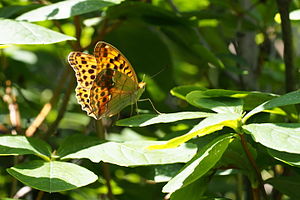Eastern mother-of-pearl butterfly
| Eastern mother-of-pearl butterfly | ||||||||||||
|---|---|---|---|---|---|---|---|---|---|---|---|---|

Eastern mother-of-pearl butterfly, Sapporo |
||||||||||||
| Systematics | ||||||||||||
|
||||||||||||
| Scientific name | ||||||||||||
| Argynnis laodice | ||||||||||||
| ( Pallas , 1771) |
The eastern mother-of-pearl butterfly ( Argynnis laodice ) is a butterfly (day butterfly ) from the noble butterfly family (Nymphalidae).
features
Both females and males of the eastern mother-of-pearl moth have a wingspan of about 50–60 mm. The top of the butterfly has an orange to yellow-brown basic color and has a black speckled pattern typical of mother-of-pearl butterflies. This consists of the unfilled cell spots , some disk spots and an irregular row of post- disc spots , followed by another row of smaller submarginal spots. The wing edge does not have a black marginal border , as is the case with the great mother-of-pearl butterfly ( Speyeria aglaja ) or the fiery mother-of-pearl butterfly ( Fabriciana adippe ), but is only framed by triangular marginal spots. The females often have a small, white subapical spot, the males on the lower fore wing veins Cu2 and A indistinct scented stripes. The underside in the outer area of the hind wings has a brown-red to purple basic color, which is interspersed with some very indistinct, sometimes barely visible rows of spots. The inner area is yellowish to greenish in color, only at the transition from the basal to the discal area is it traversed by an indistinct, brown-red line vertically; a shorter, less noticeable line follows in the disc area. The bright interior and the violet-brown exterior are separated by a white, interrupted band. The outside area is darkest here and becomes increasingly lighter towards the edge of the wing. Due to the conspicuous underside, the species can only be confused with a few others. Only with the blackberry mother-of-pearl butterfly ( Brenthis daphne ) and more distantly also with the meadowsweet mother-of-pearl butterfly ( Brenthis ino ) is there a possibility of confusion due to the similar coloring of the underside. The blackberry mother-of-pearl butterfly in particular is drawn similarly, but both of these species differ from the eastern mother-of-pearl butterfly, firstly by their smaller size and secondly by the less clearly divided color of the underside. While the yellow to greenish basal and discal region of the blackberry mother-of-pearl butterfly and the meadowsweet mother-of-pearl butterfly is criss-crossed by the brownish-red veins and divided into clear, multicolored fields, this region appears calmer and almost monochrome in the eastern mother-of-pearl butterfly. The upper side is similar to that of other mother-of-pearl butterflies, but it is easy to distinguish from them due to the squat wing shape and the large, round-oval disk spots and post-disk spots. In addition, the discal spots are usually clearly separated and not connected, as is the case with other mother-of-pearl butterflies such as the imperial mantle ( Argynnis paphia ) and the cardinal ( Argynnis pandora ).
Similar species
- Blackberry mother-of-pearl butterfly ( Brenthis daphne )
- Meadowsweet mother-of-pearl butterfly ( Brenthis ino )
Occurrence and habitat
The eastern mother-of-pearl butterfly is, as the name suggests, only widespread in Europe in eastern Europe, where it occurs very sparsely at low altitudes. The entire distribution area, however, extends from northern and eastern Poland , the Baltic States and eastern Slovakia , northern Hungary and Romania via Russia to eastern Siberia in the Amur region, Korea and Japan . The species occasionally occurs as a migratory butterfly outside of its range . Immigration areas with non-indigenous occurrences are southern Finland and the south-eastern coast of Sweden (with Gotland ), as well as the outer north-east of Germany and the Czech Republic . The western limit of distribution is thus reached on the eastern edge of Central Europe .
The main habitat is moist, flowering meadows at low altitudes. These meadows are always associated with forest, because the host plants grow there. The moths therefore fly particularly on forest meadows, forest clearings, on forest edges and forest paths.
Way of life
The flight time of the univoltine species begins in particularly warm areas in mid-June, but mostly in early July and lasts until mid-August.
The moths of both sexes particularly like to suckle on the blossoms of the blackberry ( Rubus ). Violet species ( Viola ) serve as forage plants for the caterpillars , especially the swamp violet ( Viola palustris ). The eggs are laid individually on parts of the forage plant. The caterpillars hatch from this in summer and overwinter in the litter.
Individual evidence
- ↑ a b c d Eastern mother-of-pearl butterfly (Argynnis laodice). In: Lepiforum. Retrieved May 29, 2018 .
- ↑ Vadim Tshikolovets: Butterflies of Europe and the Mediterranean area . 2011, ISBN 978-80-904900-0-0 .
- ^ A b Tom Tolman, Richard Lewington: Collins Butterfly Guide - The Most Complete Field Guide to the Butterflies of Britain and Europe . Harper Collins, London 2008, ISBN 978-0-00-727977-7 , pp. 182 .